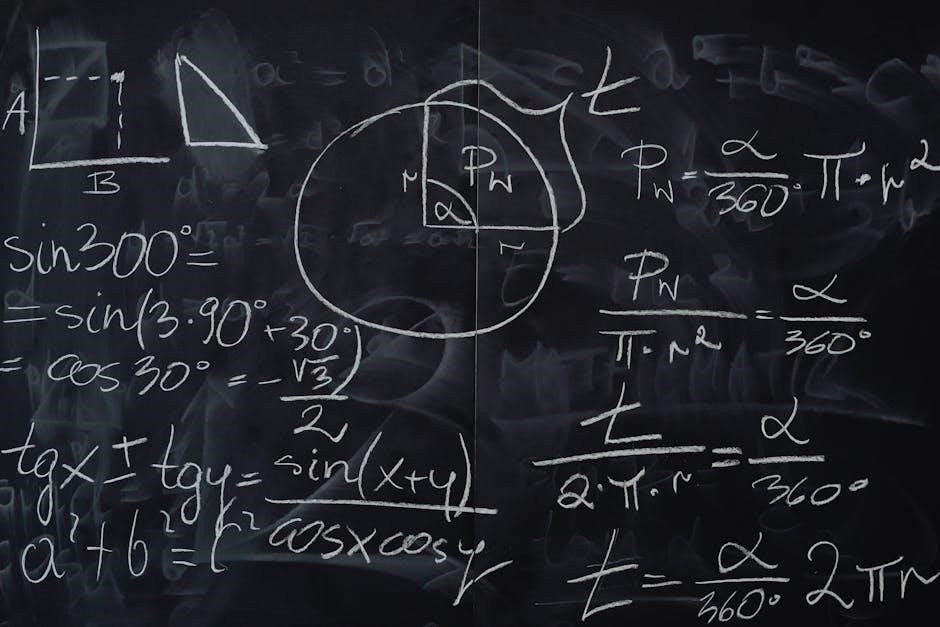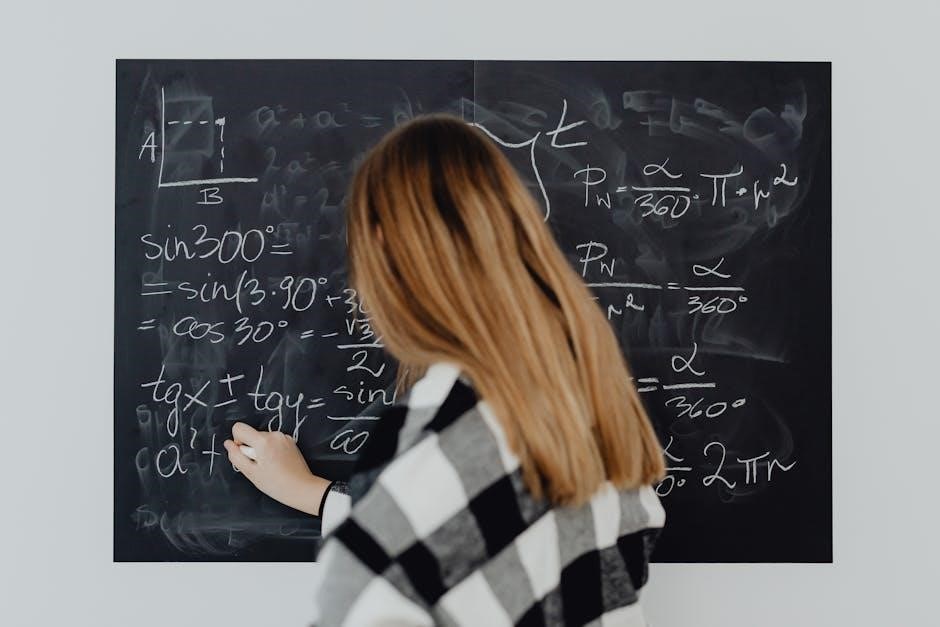Systems of equations involve multiple equations with variables, requiring solutions that satisfy all. Substitution is a method where one variable is expressed in terms of another, solving step-by-step.
1.1 What Are Systems of Equations?
A system of equations consists of two or more equations with the same variables, where the goal is to find values that satisfy all equations simultaneously. These systems often involve linear equations, such as y = 6x ౼ 11 and 2x + 3y = 7, which intersect at a single point. Solving systems of equations is fundamental in algebra, as it helps determine unknowns and model real-world problems. The substitution method is a key technique, where one variable is expressed in terms of another and substituted into the second equation for a solution.
1.2 Importance of Solving Systems of Equations
Solving systems of equations is essential in algebra as it builds problem-solving skills and applies to real-world scenarios. These systems model relationships between variables in fields like physics, engineering, and economics. Mastering this skill enhances critical thinking and prepares students for advanced mathematics. Worksheets like “Solving Systems of Equations by Substitution” provide structured practice, ensuring proficiency in methods like substitution and elimination. Understanding systems of equations is fundamental for tackling complex problems and fostering mathematical literacy. Regular practice with worksheets helps reinforce concepts and improves accuracy in solving multi-variable problems.
Understanding the Substitution Method
The substitution method involves solving one equation for a variable and substituting it into the other equation. This step-by-step approach simplifies solving systems of equations.
2.1 Definition and Basic Concept
The substitution method is a strategy to solve systems of equations by expressing one variable in terms of another. It involves isolating a variable in one equation and substituting this expression into the other equation. This approach simplifies the system by reducing it to a single equation with one variable, making it easier to solve. The method is particularly effective for systems where one equation can be easily manipulated to express a variable. By substituting, you eliminate one variable at a time, leading to a straightforward solution process.
2.2 Step-by-Step Guide to the Substitution Method
Choose one equation and solve for one variable in terms of the other.
Substitute this expression into the corresponding variable in the second equation.
Simplify and solve for the remaining variable.
Plug the found value back into the original solved equation to find the second variable.
Verify the solution by substituting both values into the original equations to ensure they satisfy both.

Practical Examples of Solving Systems by Substitution
Examples include solving systems like y = 6x ౼ 11 and 2x + 3y = 7 by substituting y = 6x ౼ 11 into the second equation.
3.1 Example 1: Solving for y in a Simple System
Consider the system:
( y = 6x — 11 )
( 2x + 3y = 7 )
Substitute ( y = 6x ౼ 11 ) into the second equation:
( 2x + 3(6x ౼ 11) = 7 ).
Simplify: ( 2x + 18x ౼ 33 = 7 ).
Combine like terms: ( 20x — 33 = 7 ).
Add 33 to both sides: ( 20x = 40 ).
Divide by 20: ( x = 2 ).
Substitute ( x = 2 ) back into ( y = 6x — 11 ):
( y = 6(2), 11 = 12 ౼ 11 = 1 ).
Solution: ( (x, y) = (2, 1) ).
3.2 Example 2: Solving for x in a Two-Variable System
Take the system:
( y = 5x — 7 )
( 3x + 2y = 12 )
Substitute ( y = 5x — 7 ) into the second equation:
( 3x + 2(5x ౼ 7) = 12 ).
Simplify: ( 3x + 10x — 14 = 12 ).
Combine like terms: ( 13x ౼ 14 = 12 ).
Add 14 to both sides: ( 13x = 26 ).
Divide by 13: ( x = 2 ).
Substitute ( x = 2 ) back into ( y = 5x ౼ 7 ):
( y = 10 — 7 = 3 ).
Solution: ( (x, y) = (2, 3) ).
Common Mistakes and Tips for Avoiding Errors
Common errors include incorrect substitution, arithmetic mistakes, and forgetting to verify solutions. Always check work and ensure substitutions are accurately applied to avoid errors in systems.
4.1 Identifying and Correcting Algebraic Mistakes
Algebraic mistakes in substitution often stem from incorrect sign handling or miscalculations. Identify errors by carefully re-examining each step. Ensure variables are correctly substituted and simplified. Verify solutions by plugging them back into original equations to confirm accuracy. Common pitfalls include forgetting to distribute negatives or misaligning coefficients during substitution. Double-checking work after each step can prevent such errors, fostering accuracy and confidence in solving systems of equations effectively.
4.2 Strategies for Double-Checking Solutions
To ensure accuracy, substitute found values back into original equations. Verify that both sides equal, confirming the solution’s validity. Additionally, use alternative methods like elimination or graphical interpretation to cross-validate results. Comparing solutions from different approaches enhances confidence. Organizing work neatly and systematically reduces errors. Regular practice and reviewing common mistakes also improve proficiency in solving systems of equations by substitution, making the process more efficient and reliable over time.

Substitution vs. Elimination Methods
Substitution and elimination are two primary methods for solving systems. Substitution is ideal when variables are easily isolated, while elimination excels with aligned coefficients for straightforward combination.
5.1 When to Use Substitution vs. Elimination
Substitution is best when one equation can easily solve for a variable, simplifying substitution into the other equation. Elimination is preferred when variables have common coefficients, allowing for easy elimination by adding or subtracting equations. Choosing the right method depends on the system’s structure and complexity. Substitution often leads to fewer arithmetic errors, while elimination can be more efficient for systems with aligned coefficients. Understanding both methods ensures flexibility in solving various systems effectively.
5.2 Comparing the Two Methods
Substitution and elimination are both effective for solving systems of equations, but they differ in approach. Substitution involves expressing one variable in terms of another and substituting it into the second equation. Elimination focuses on manipulating equations to eliminate one variable by adding or subtracting them. Substitution is often simpler for systems where one equation is easy to solve for a variable. Elimination is advantageous when coefficients align, making it easy to cancel a variable. Both methods require algebraic precision, but substitution can reduce arithmetic complexity, while elimination streamlines variable removal. The choice depends on the system’s structure and personal preference.

Creating a Solving Systems of Equations Worksheet
A systems of equations worksheet should include a variety of substitution-based problems. Ensure clarity in instructions and provide answers for self-assessment to aid student learning and better understanding.
6.1 Designing Effective Problems for Practice
Effective problems for practice should cover a range of difficulty levels, from simple to complex systems. Start with straightforward equations and gradually introduce more challenging scenarios. Ensure clarity in the problem statements and avoid ambiguous language. Include systems that require solving for both variables and those with real-world applications to enhance relevance. Provide a mix of problems that can be solved using substitution, allowing students to apply their understanding in diverse contexts. This variety helps reinforce learning and prepares students for different types of equations they may encounter.
6.2 Including Answers for Self-Assessment
Including answers in a worksheet allows students to verify their solutions independently. Place answers at the end or beside each problem for easy comparison. Clear formatting ensures students can quickly identify correct solutions. Providing detailed steps alongside answers helps clarify common mistakes. This feature fosters self-assessment, enabling learners to track progress and understand where errors occur. Answers also serve as a resource for reviewing concepts and reinforcing problem-solving skills. Ensure answers are accurate and match the problems to maintain credibility and effectiveness in the learning process.

Advanced Problems and Challenges
Solving complex systems with multiple variables and applying substitution in real-world scenarios challenges students to think critically and apply mathematical concepts effectively.
7.1 Solving Systems with More Than Two Variables
Solving systems with more than two variables requires extending the substitution method. Start by expressing one variable in terms of others and substitute it into all equations. For example, in a three-variable system, solve one equation for a variable and substitute it into the other two equations. This reduces the system to two equations with two variables, which can then be solved using substitution or elimination. Organizing equations carefully and checking substitutions are crucial to avoid errors. Advanced problems often involve real-world applications, making critical thinking and precise algebraic manipulation essential.
7.2 Applying Substitution to Real-World Scenarios
Substitution is valuable in real-world scenarios like budgeting, engineering, and economics. For example, determining the cost and quantity of items when given total costs and discounts. In engineering, it can model multiple forces or currents. Start by defining variables and translating real-world conditions into equations. Solve one equation for a variable and substitute into others to find solutions. Practical problems often involve multiple variables, requiring careful substitution and verification. This application demonstrates the power of substitution in solving complex, meaningful scenarios, enhancing both problem-solving skills and real-world understanding through algebraic methods.
Mastering substitution enhances problem-solving skills, offering practical applications in real-world scenarios. Regular practice with worksheets reinforces understanding and proficiency in solving systems of equations effectively.
8.1 Summary of Key Concepts
8.2 Encouragement for Further Practice
Practice is essential to master solving systems of equations by substitution. Regularly working through worksheets and challenging problems sharpens your algebraic skills and problem-solving abilities. Start with simple systems and gradually tackle more complex ones, such as those involving real-world scenarios or multiple variables. Use online resources or textbooks to find additional exercises and assess your progress. Consistent effort will build confidence and fluency, preparing you for advanced mathematical concepts. Embrace challenges and enjoy the process of improving your problem-solving skills!

